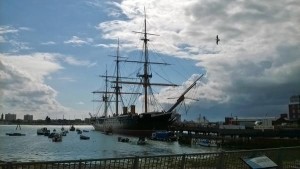 Last week I attended the annual Social History Society conference held at the University of Portsmouth. It was my first Social History Society conference, and I was particularly lucky to have the opportunity to present a paper on sailors and naval pageantry alongside my PTUC colleagues Daniel Swan and Chris Spackman on the first panel of the ‘Spaces and Places’ strand, chaired by Rob James.
Last week I attended the annual Social History Society conference held at the University of Portsmouth. It was my first Social History Society conference, and I was particularly lucky to have the opportunity to present a paper on sailors and naval pageantry alongside my PTUC colleagues Daniel Swan and Chris Spackman on the first panel of the ‘Spaces and Places’ strand, chaired by Rob James.
Although possibly somewhat biased as a member of the University of Portsmouth, I found it to be a wonderful conference with a wide range of papers on a vast number of topics which prompted excellent discussion. I would like to extend my thanks to all the organizers and volunteers who together made the event such a success.
With seven panels running consecutively throughout the three days it was a challenge to see all the papers I wanted to but twitter was awash with useful snippets and key arguments being put forward – the benefits of 21st Century Academia!
What follows is a brief report on the papers that I saw over the course of the conference.
Day one
Arriving early, I missed out on the opening stages of the conference as I was presenting on the first panel of the ‘Spaces and Places’ strand.
Chris Spackman opened the panel with his paper looking at the summer camps of the Boy’s Brigade in port towns from 1886 – 1933. Chris argued that Boy’s Brigade camps have been studied in isolation which has ignored the the variances caused by different locations and situations. Chris focused on the specific examples of London, Bristol and Glasgow to demonstrate this. The second paper, by Daniel Swan, assessed the experiences of women working in Portsmouth Dockyard during World War II. By using oral testimony from those working “inside the wall”, Daniel argued that the Second World 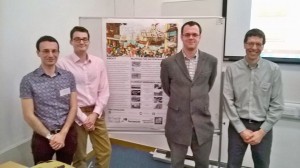 War did not dramatically change the working experience for women but can be seen as a liberating experience on a personal level. I then concluded the panel with my paper which explored pageantry in the Royal Navy and its ‘forgotten’ participants from c. 1890 to 1914. The crux of my argument being that sailors, as the forgotten participants, were both spectators and part of the spectacle, and through the use of sailor diaries exhibited a range of emotions both in support of their imperial role and against it.
War did not dramatically change the working experience for women but can be seen as a liberating experience on a personal level. I then concluded the panel with my paper which explored pageantry in the Royal Navy and its ‘forgotten’ participants from c. 1890 to 1914. The crux of my argument being that sailors, as the forgotten participants, were both spectators and part of the spectacle, and through the use of sailor diaries exhibited a range of emotions both in support of their imperial role and against it.
Lunch gave the first opportunity to meet some of the other delegates and have a quick look at the first few posters including the PTUC poster designed by Louise Moon.
After lunch I went to the ‘Economies, Culture and Consumption’ panel chaired by Penny Summerfield with papers tying together the culture and remembrance of war-time rationing.
The first paper, by Hayley Cross, provided an interesting look at remembering rationing in Scotland during the Second World War. Her use of oral testimony demonstrated the real human side to the situation of rationing. Hayley used the oral testimony to explore themes of gender, family and communities, and how they made sense of what they experienced including the black market.
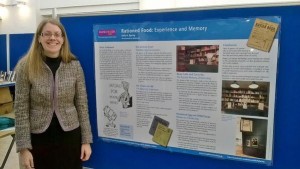 This was neatly followed by Kelly Spring, who considered the popular memory of Second World War rationing and gender history in the Imperial War Museum. Kelly discussed the gendering of memory and history, and the strategy of connecting past and present: rationing and the recession. Kelly also took part in the poster display in the atrium of Portland Building.
This was neatly followed by Kelly Spring, who considered the popular memory of Second World War rationing and gender history in the Imperial War Museum. Kelly discussed the gendering of memory and history, and the strategy of connecting past and present: rationing and the recession. Kelly also took part in the poster display in the atrium of Portland Building.
The panel was concluded by The Social History Society’s Karen Hunt, discussing some general points of women and the invention of rationing in the First World War with the key point being that what we know about Second World War rationing demonstrates what we cannot know about the First.
Following a quick coffee break we moved into the final panel of the day. I opted for the ‘Global and Transnational Approaches’ strand with its focus on Mediterranean ports.
Matteo Barbano kicked off with a paper on merchants and adventurers in English Tangiers, and discussed the “pervious border” of the Mediterranean Sea. Matteo argued that it was a “claustrophobic colony” but one that offered many social advancements with a collective merchant network despite the colony’s short lifetime.
Danilo Pedmonte continued in this vein with his paper on British merchants, sailors and privateers in Leghorn. A cosmopolitan port, Danilo described the “British Factory” of small traders, ship owners, artisans, and sailors and argued that despite being “strangers” the national support from other British inhabitants was important to the development of the port.
The final paper of the afternoon was by Sarah Watkinson with an interesting look at the records of early nineteenth-century Malta. Sarah presented a case study of the Stevens family of notaries, and their involvement in trade at a time when British merchants were arriving and the port city of Valletta was becoming an economic trade hub.
The day ended with a drinks reception, providing a chance to relax and continue discussion from the day’s many papers. We were also treated to some rather suitable naval-themed entertainment: sea shanties by the Shantymen.
Day two
An early start found me at a particularly interesting paper by Vicky Davis in the ‘Economies, Culture and Consumption’ panel, considering Post Office employees and their duties to the nation c.1880 -1918. Her paper delved into the individual histories of those men who worked for the GPO highlighting the links between their everyday work and war work and providing a useful framework of analysis.
This was followed by an intriguing approach to masculinity and the narrative of work in 1950s Australia by Chelsea Barnett. With a key focus on the film King of the Coral Sea, Chelsea highlighted the importance of the gendering and class-based values of work, and technical innovation.
The panel was rounded off by Peter Bent’s paper on the development of “precarious” work in India under British imperialism. Peter considered the industrialization of India during the British Raj, moving away from many studies which have focused on the period after the Second World War. Peter argued that precarious work could take a number of forms and stood in stark contrast to the stable employment seen in the West.
After some much needed coffee I returned to the ‘Spaces and Places’ panel looking at Urban Life. Colin Pooley’s use of diaries to examine the everyday experiences of urban travel in the past was particularly insightful, coming from a diary-influenced field of research myself.
Laura Harrison’s paper on young people and spatial knowledge – walking for pleasure – provided an insightful approach to youth and urban spaces, and the conscious use of parading as a common ritual of socialization. Laura examined how this exercise provided the opportunity for sociability and intimacy, and the importance of their engagement with urban spaces.
Following on nicely, Klaus Nathaus’ paper discussed his current project which looks at entertainment places and social relations in western cities from the late nineteenth century and twentieth century. Klaus explored the social conventions that governed interaction in public space with a particular focus on the rise of the “crooners” in the 1950s and audience reaction. Klaus even attempted to croon to us!
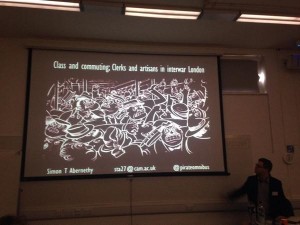 The final paper before lunch was by Simon Abernethy looking at class and commuting in inter-war London. A dynamic paper, Simon discussed the changing image of the commuter and the apparent breakdown of social distinction, arguing that although the Great War disrupted this, by the 1930s this was being reasserted.
The final paper before lunch was by Simon Abernethy looking at class and commuting in inter-war London. A dynamic paper, Simon discussed the changing image of the commuter and the apparent breakdown of social distinction, arguing that although the Great War disrupted this, by the 1930s this was being reasserted.
After the break for lunch I ducked into the ‘Deviance, Inclusion and Exclusion’ strand focusing on gender and crime. The first paper, by Charlotte Mallinson, discussed the sanitizing and sensationalizing of the violent acts committed by Jack the Ripper. Charlotte reminded us that the Ripper’s victims were real people and need to be put back into the Ripper discourse in their own right.
This was followed by Anais Pedron’s paper on women and war, which highlighted the role of French women breaking traditional gender roles. Refusing to be subordinate, and instead acting on their own initiative, Anais demonstrated the importance of considering the contribution of women in what remains, for the most part, a man’s world.
The final paper was by Maria Romero Ruiz on the London Lock Charities, considering poor reform beyond venereal disease. Maria discussed how the London Lock formed part of the attempt to indoctrinate and educate the poor by the evangelical middle classes.
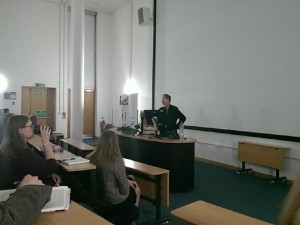 The day was concluded with the keynote, delivered by Professor Jonathan Hyslop of Colgate University entitled: Navigating Empire: Ports, Ships and Global History. A fascinating and stimulating paper, reinforcing the importance of ports, ships and global history, particularly the dynamic of sailors and ports and raised the important point of the need to refocus our attention on the voyages – a point that sits at home with my own research on sailor diaries. It was great to see Jonathan back in Portsmouth and made our own conference seem an age ago!
The day was concluded with the keynote, delivered by Professor Jonathan Hyslop of Colgate University entitled: Navigating Empire: Ports, Ships and Global History. A fascinating and stimulating paper, reinforcing the importance of ports, ships and global history, particularly the dynamic of sailors and ports and raised the important point of the need to refocus our attention on the voyages – a point that sits at home with my own research on sailor diaries. It was great to see Jonathan back in Portsmouth and made our own conference seem an age ago!
After this we made our way down to the Southsea sea front for the conference dinner at the Queen’s Hotel. The hotel’s fading grandeur provided an excellent environment to continue our discussions over a fine dinner and unwind with a couple of glasses, or more…
Day three
A little bit of a later start – probably for the best given the late hour we left the conference dinner! – I went along to the ‘Narratives, Emotions and the Self’ strand for a panel on Collective Memory, Identity and Nostalgia.
Chris Jeppesen’s paper on the Overseas Service Pensioners’ Association and popular memory of empire discussed the way in which the popular memory of imperialism is sanitized and highlighted the difference between “imperial nostalgia” as the loss of national status and “colonial nostalgia” as the loss of the cultural attributes of imperialism.
Sophie Cooper’s paper on the Irish and demonstrations of Irishness abroad demonstrated their compromised identities. Demonstrating just how permanent the image is of the Irish enjoying a “good time”, Sophie instead sought to show how the Irish saw themselves once abroad and their interaction with their new environments focusing particularly on Melbourne and Chicago in the nineteenth century.
The final paper by Laura Crombie on ‘War, national identity and urban communities’ considered the experiences of Tournai through war, conquest and its effect on the town’s identity. Laura presented a fascinating study which demonstrated the complexities of emotions and attitudes towards nationalism and individuality.
Moving into the final panel of the conference I finished where I started, with the ‘Spaces and Places’ panel.
Hannah Baxter’s paper on ‘Allotments and the Great Depression in Scotland’ demonstrated the importance of “self-help” rather than “charity” to get the unemployed back into employment by using the Scottish Allotments Scheme for the Unemployed. Hannah considered how the use of allotments was changed, and how this has shaped the image of allotments in Scotland today.
Keeping things green-fingered, Claire Hickman’s study of botanic gardens and their place in the teaching of medicine was thoroughly refreshing. Considering the utilization of botanic gardens as spaces and a source of material it was suggested that these formed an “outside library” for teaching medical students.
Joseph Curran’s look at philanthropy in the “stateless capitals” (a wonderful phrase!) considering Dublin and Edinburgh was, again, an interesting look at spaces and philanthropy. Investigating the interaction between “established” and “new” institutions, Joseph considered the impact of capital status and the national and local focus, and identities in these cities.
The panel was concluded by James Camp, looking at the lure of the spa town: Bath in the seventeenth century. James argued that the later prosperity and development of Bath in the eighteenth century was actually based upon the drive of the many who visited the spa town during the seventeenth century for its health benefits, risking the dangers of the road.
As we met for the final lunch the numbers were already thinning, and even the stalwarts disbursed soon after. It was good to hear that a number of people were not leaving immediately though and were staying on to explore some of Portsmouth’s heritage.
In all it was a hugely enjoyable conference with some truly thought-provoking papers, within a friendly, encouraging atmosphere. One of the things that really struck me was the interconnectedness of it all – the key themes that were present in each panel and paper. It was fantastic to meet so many great people working on some truly amazing areas of research.










Comments are closed.